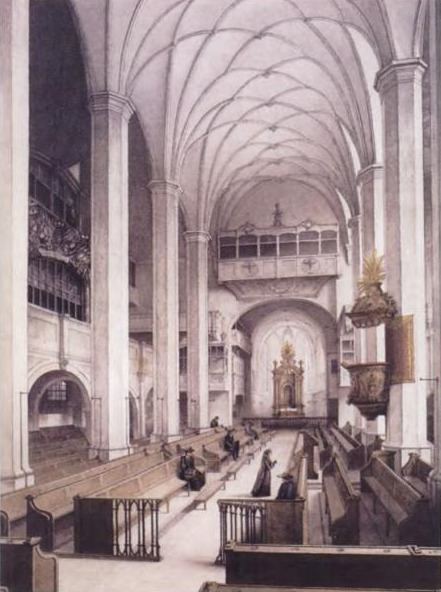Movements 6 | Cantata text Christoph Birkmann | |
 | ||
Vocal soprano and bass soloists | ||
Ich geh und suche mit Verlangen (I go forth and seek with longing), BWV 49, is a church cantata by Johann Sebastian Bach. He composed the solo cantata, a dialogue of soprano and bass, in Leipzig for the twentieth Sunday after Trinity Sunday and first performed it on 3 November 1726.
Contents
History and words
Bach composed the cantata in his fourth year in Leipzig for the twentieth Sunday after Trinity. It is counted as part of his third annual cycle of cantatas. The prescribed readings for the Sunday were from the Epistle to the Ephesians, "walk circumspectly ... filled with the Spirit" (Ephesians 5:15–21), and from the Gospel of Matthew, the parable of the great banquet (Matthew 22:1–14). The German term used in Luther's Bible translation is Hochzeitsmahl (wedding meal). The cantata is termed a Dialogus, being a dialogue between the Soul and Jesus, her bridegroom. The source for the dialogue is, here as in many works of the 17th century, the Song of Songs. Poet Christoph Birkmann derived from the wedding feast of the Gospel the Soul as the bride whom Jesus invited to their wedding, while the other characters of the story are not mentioned in the cantata. The poet alludes to the Bible several times, comparing the bride to a dove as in Song of Songs 5:2 and Song of Songs 6:9, referring to the Lord's feast (Isaiah 25:6), to the bond between the Lord and Israel (Hosea 2:21), to faithfulness until death (Revelation 3:20), and in the final movement to "Yea, I have loved thee with an everlasting love: therefore with loving kindness have I drawn thee." (Jeremiah 31:3). Instead of a closing chorale, Bach combines this idea, sung by the bass, with the seventh stanza of Philipp Nicolai's mystical wedding song "Wie schön leuchtet der Morgenstern", given to the soprano.
Bach first performed the cantata on 3 November 1726.
Scoring and structure
Bach structured the cantata six movements and scored it for soprano and bass soloists, oboe d'amore, two violins, viola, violoncello piccolo, organ and basso continuo. Klaus Hofmann summarizes: "Bach has clothed his music in the 'wedding garments' of exquisite scoring".
- Sinfonia
- Aria (bass): Ich geh und suche mit Verlangen
- Recitative (soprano, bass): Mein Mahl ist zubereit'
- Aria (soprano): Ich bin herrlich, ich bin schön
- Recitative (soprano, bass): Mein Glaube hat mich selbst so angezogen
- Aria (bass) + Chorale (soprano): Dich hab ich je und je geliebet – Wie bin ich doch so herzlich froh
Music
The cantata is opened by a sinfonia for concertante organ and orchestra, probably the final movement of a lost concerto composed in Köthen, the model for the Concerto II in E major, BWV 1053, for harpsichord. Two weeks before, Bach had used the two other movements of that concerto in his cantata Gott soll allein mein Herze haben, BWV 169. The bass as the vox Christi sings the words of Jesus. In the soprano aria "Ich bin herrlich, ich bin schön" (I am glorious, I am beautiful) the bride reflects her beauty as dressed in "seines Heils Gerechtigkeit" (The justice of His salvation), accompanied by oboe d'amore and violoncello piccolo. The cantata ends not with the usual four-part chorale, but with a love duet of the Soul (soprano) and Jesus (bass). It incorporates a chorale, stanza 7 of Nicolai's hymn, ending with the line "Deiner wart ich mit Verlangen" (I wait for Thee with longing), while the bass responds: "I have always loved you, and so I draw you to me. I'm coming soon. I stand before the door: open up, my abode!" John Eliot Gardiner describes the mood of the music, accompanied by the obbligato organ, as "religious-erotic". Hofmann notes that the figuration of the organ expresses in sound what the cantus firmus words: "Wie bin ich doch so herzlich froh!" (How sincerely happy I am!) Musicologist Julian Mincham suggests that this cantata "exudes a greater degree of personal intensity" than the previous two for this day, BWV 162 and 180.
